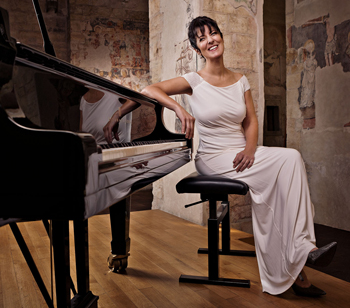by Robert Rollin

The program’s highlight was her performance of Franz Schubert’s last piano sonata, No. 21 in B-flat, published posthumously. Shapiro referred to it as the “Mt. Everest” of his piano music, explaining that its richness brought her father to mind. Her focused performance was gorgeous.
The Molto moderato was serene, reflective, and joyful. Though Shapiro always brought out important voices, she never overemphasized them as some pianists do. Her interpretation was clear and transparent, never blatant.
When the second theme appeared in the left hand, she tossed off the triplet filigree in the right hand to perfection, carefully shaping the long and powerful crescendo to the climax. She maintained gentle, balanced voicing even when the tune returned with a sudden drop to pianissimo.
The Andante sostenuto, in the distant key of C-sharp minor, began very softly and expressively. Shapiro gracefully crossed left hand over right to bring out individual notes, maintaining forward motion through chromatic modulations to reach the forte climax of the A-major section. When Schubert returns to the A-section and adds a coda in C-Sharp Major, Shapiro allowed the music to poignantly dissolve in mid-air.
The short Scherzo, Allegro vivace con delicatezza, shot by at dizzying speed. In the trio Shapiro deftly maintained a beautiful balance between the right and left hands.
The pianist’s dynamic control helped energize the sudden fortissimos in the Allegro ma non troppo. She took advantage of its hauntingly tuneful moments with verve and intensity. Beautifully milking the silences between loud interjections, she dashed to the sudden ending of the Presto.
The recital began with Anatoly Liadov’s Two Mazurkas, Op. 15, miniature Polish dances. The first displayed Shapiro’s strong technique and dynamic skill. She explained that the second employed the Dorian mode, bringing to mind her father’s bravery during World War II.
Shapiro chose the Chopin Barcarolle in F-sharp, Op. 60, because, as a boat song, it reminded her of her father’s wartime South American and African sea voyages. Her unerring left hand played the complex, disjunct accompaniment with precision as her right hand soared.
She explained that Sergei Rachmaninoff’s Variations on a Theme by Corelli, Op. 42, was both dark and joyful, reflecting her father’s struggles and arrival in America. Rachmaninoff wrote challenging variations on Corelli’s simple Baroque theme, and Shapiro played them flawlessly, surging with power when appropriate. She magnificently brought out the short staccato chords and daunting arpeggios.
Published on ClevelandClassical.com November 27, 2017.
Click here for a printable copy of this article



